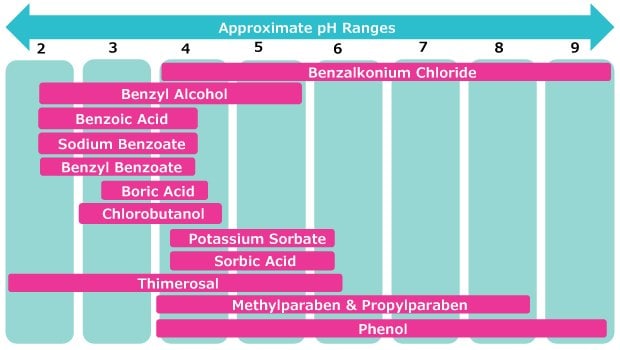Criteria for Selecting Preservatives Used in Liquid Formulation
In pharmaceutical formulations, various ingredients can foster microbial growth, making these products vulnerable to unwanted contamination. Using preservatives in pharmaceutical drug products helps increase the shelf life and prevent microbial decomposition growth. This is especially important for multi-use liquid formulations, which may include injectable liquid, ophthalmic liquid, topical semi-solid/liquid, oral liquid, and nasal solutions.
Selecting the best suitable preservative for your liquid formulation requires careful consideration as the preservative should inhibit microbial proliferation, but not interfere with the product's overall performance.
Section Overview
Considerations When Selecting Preservatives
To ensure effective preservation, any chosen antimicrobial agent must meet several key criteria:
- Wide anti-microbial activity: The preservative should demonstrate a wide range of antimicrobial activity against various microorganisms at low concentrations.
- Broad pH range activity: It must retain its antimicrobial properties throughout the manufacturing process, shelf life, and usage, including across a broad pH range.
- Compatibility: The preservative should be compatible with other formulation components.
- High quality and purity: Especially for high-risk applications, high product quality and purity is crucial.
- Chemical inertness: The preservative should not compromise the quality or performance of the product, packaging, or delivery system.
- Non-toxicity: It is vital that the preservative is non-toxic and does not negatively impact patient safety or product tolerance.
The criteria listed above serve as a guide for selecting the optimal preservative for a specific product.
Key considerations for preservative selection include:
- Application: Preservatives are used in a wide range of applications, such as ophthalmic, oral, and parenteral formulations.
- Formulation pH: Formulations may be acidic, neutral, or alkaline.
- Formulation type: aqueous, non-aqueous or lyophilized
- Concentration: Selection should be based on safety and toxicity considerations.
- Microbial activity: Effectiveness against bacteria, molds, and yeast is essential.
- Incompatibilities: Consideration of potential adsorption, degradation, and complexation is crucial.
- Synergistic effects: Some agents may enhance the action of preservatives.
- Target patient population: Special attention is needed for pediatric patients, particularly regarding the use of benzyl alcohol and benzoic acid.
Below, we examine the different aspects to consider when selecting preservatives for your liquid formulation.
Application
Preservatives are essential in sterile formulations like eye drops and multi-dose injections to maintain sterility during use. They may also be incorporated into aqueous injections that cannot be sterilized in their final containers and must be prepared with aseptic techniques. Additionally, preservatives are utilized in cosmetics, food products, and non-sterile pharmaceuticals, such as oral liquids and creams, to prevent microbial spoilage. Their application is not arbitrary; certain preparations, like injections into cerebrospinal fluids, eyes, or the heart, should remain preservative-free.
While a wide range of preservatives is employed in various pharmaceutical and biopharmaceutical products to extend shelf life and reduce microbial contamination, four preservatives dominate the market, representing about three-quarters of those used in pharmaceutical products: parabens (including methylparaben and propylparaben), benzalkonium chloride, benzyl alcohol, and sodium benzoate.
pH of Formulation
The pH level of a formulation plays a crucial role in several aspects, including patient comfort, the stability and solubility of the active ingredient(s), and the growth rate of microorganisms. Additionally, it directly impacts the effectiveness of preservatives by affecting their interaction with microbial cell wall components and determining the minimum inhibitory concentration (MIC).
The preservative used should be selected based on whether it has maximal microbial activity at the pH of the formulation (Figure 1). A mixture of preservatives can be used to target a complete microbial population to inhibit microbial growth of the product across a wide pH range (e.g., benzyl benzoate with benzyl alcohol, boric acid with either benzalkonium chloride or sorbic acid). Because they are active in a broad pH range (pH 4-9), benzalkonium chloride and parabens are commonly used preservatives.

Figure 1.Approximate pH range where various preservatives can be used.2
Synergistic Antimicrobial Activity
Preservatives can be used in combination with one another or with preservative synergists such as chelating agent ethylenediaminetetraacetic acid (EDTA) or its salts to target a range of microbes including bacteria, yeast, and molds. Some common preservative synergies include:
- Benzalkonium chloride is often used in conjunction with Na-EDTA, benzyl alcohol, phenylethanol, or phenylpropanol to improve its effectiveness against Pseudomonas strains, against which benzalkonium chloride alone shows only limited efficacy.3
- Benzalkonium chloride is also frequently combined with boric acid, which is reported to show synergistic effects with quaternary ammonium compounds and serves as a buffer in ophthalmic formulations, helping to maintain a physiological pH level.3
- The use of paraben combinations, such as methylparaben and propylparaben, leverages their synergistic effects to enhance antimicrobial activity. Additionally, these combinations can help address solubility issues, as the joint use allows for lower concentrations of each individual paraben.4
- Interestingly, while low levels of EDTA can diminish the activity of thimerosal through complexation, higher concentrations are reported to enhance thimerosal's antimicrobial effectiveness.5
Targeted Patient Population
The same preservative might not be suitable in all target patient populations (e.g., pediatric or geriatric). For example, benzyl alcohol and benzoic acid should not be used in neonates and should be used with caution in children older than four weeks as they cannot be metabolized by the liver and can then cross the blood-brain barrier.
Preservative Profiles for Liquid Drug Formulation
With so many preservative options available, it can be difficult to identify the best preservative(s) for your liquid formulation. Taking the above-mentioned considerations can help you hone in on the best options.
To learn more about a preservative in detail, see individual preservative profiles.
Related Products
References
To continue reading please sign in or create an account.
Don't Have An Account?